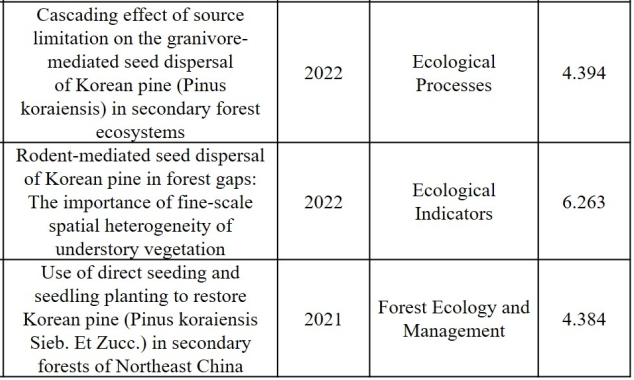Korean pine (Pinus koraiensis) is a constructive tree species in the broad-leaved trees/Korean pine mixed forest in Northeast China. However, this type of old-growth forest has badly degraded due to long-term destructive disturbance and nearly all the old-growth forests have been converted to secondary forests. Promoting the regeneration of Korean pine in the secondary forest ecosystem is crucial to restore the old-growth forests in Northeast China. However, studies on artificial regeneration (direct sowing and planting of seedlings) of Korean pine often ignore the roles of seed predators, for example the damage of seeds and seedlings caused by rodents. In addition, when Korean pine cones mature and fall off, they must rely on rodents to disperse seeds. Therefore, exploring the effects of secondary forest structure regulation (e.g., thinning or gap formation) on rodents-mediated regeneration of Korean pine is an urgent need for the restoration of secondary forests and the protection of Korean pine germplasm resources.
To this end, Researchers ZHU Jiaojun, Wang Gaofeng, Yan Qiaoling, and Doctoral Student Wang Jing from the Secondary Forest Ecology and Management Group of the Institute of Applied Ecology (IAE) of the Chinese Academy of Sciences (CAS) conducted a series of research and achieved the following research results:
(1) Korean pine seed provenance limitation coupled with changes in forest stand structure limits Korean pine seed dispersal by rodents
The researchers found that thinning could increase seed predation, reduce the proportion of seed germination and seedling formation, and reduce the effectiveness of seed dispersal by animals. Both the lack of Korean pine seed sources and the changing forest stand structure by thinning can limit rodents-mediated regeneration of Korean pine in secondary forests. To enhance the regeneration of Korean pines, the researchers suggested that forest managers should ban against Korean pine seed harvesting and protect rodent-Korean pine interactions.
(2) Rodents-induced dispersal of Korean pine seeds and the heterogeneity of understory microhabitats
The researchers found that the canopy coverage of 0.2-0.3 can be beneficial to seed predation. When canopy coverage is greater than 0.8, the Korean pine seeds can be less frequently fed and stored by rodents.
(3) Effects of artificial regeneration of Korean pine on the structure of secondary forest stand in the presence of rodents
The researchers' study showed that direct sowing Korean pine seeds in secondary forests is not an effective strategy for the regeneration of Korean pines when rodents are common seed predators in the forests. The researchers thus recommended forest managers to create large gaps and plant 3-year-old Korean pine seedlings in secondary forests to effectively accelerate the succession of secondary forests to broad-leaved trees/Korean pine mixed forests.
The above research results have been published in three papers as shown in the table below. These studies were funded by the National Natural Science Foundation of China, the Strategic Priority Research Program of the Chinese Academy of Sciences and the Liaoning Revitalization Talents Program, etc.

YUE Qian
Institute of Applied Ecology, Chinese Academy of Sciences
Tel: 86-24-83970317
E-mail: yueqian@iae.ac.cn
Web: http://english.iae.cas.cn